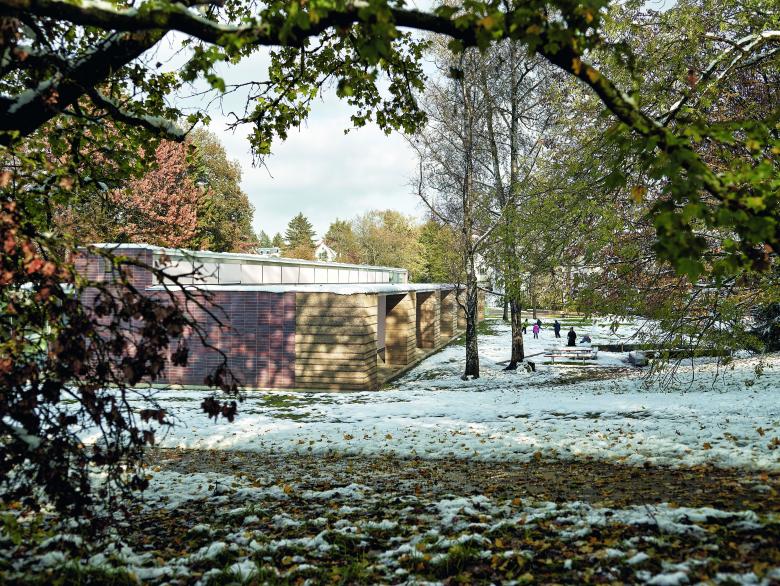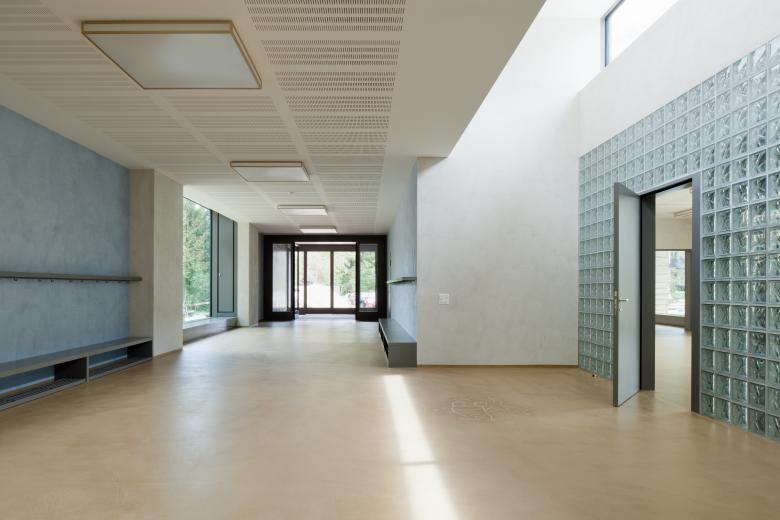School pavilion Allenmoos II
Zurich, Switzerland
The existing school pavilion, built in 1958 by Jacob Padrutt (1908–1960) as an extension of the neighboring school complex, was redesigned, expanded and converted into an after-school care and school building. The floor plan and cross section are based on the predecessor's designs; however, they are modified in such a way that the compact structure placed in the surrounding area becomes a living organism that connects with its surroundings. The building is embedded in a green zone that forms the urbanistic backbone of the district. This connects important public buildings and facilities and, together with the adjoining residential areas, forms an open, park-like urban landscape. The organically formulated space and path system of the surrounding landscape design mirrors the building's themes in that the benches and play areas are enclosed by rammed concrete walls. The KolumbaTM bricks of the facades are used as grass pavers.
An extension of the building’s figure, combined with a softening the repetitive structure of the rooms, create a kind of head at the western end of the building, which completes the volume and firmly anchors it in the terrain. A new loggia to the south mediates between the house and the cultivated surrounding nature not only spatially, but also symbolically and in the material presence of the rammed earth. With strong corners and a regular rhythm, its columns emphasize the low, elongated shape of the building, referring to its internal structure with six rows of consecutive, interconnected rooms. Even the rear facade, although intended as a much more compact, protective shell towards the public path, does not forego spatial depth. The windows with their side ventilation openings are set in the wall in such a way, they allow their strength to be experienced.
Inside, recesses of varying depths together with the opposing entry zones of the after-school care and schoolrooms, accentuated by light from above, activate the transverse direction of the long circulation area. Since the rhythms of the two longitudinal walls are not congruent, the spatial assignments become complex, so that the corridor becomes a hall. Like a backbone, the skylight sits lengthways on top of the building. It connects the entrance hall with the rooms by a meandering middle wall, causing the light to fall alternately in both areas. The rooms are given a strong backdrop by the bright recess that is created in this way. Primarily, the rooms are oriented towards the loggia and the garden. Here, too, the mighty windows are spatially formed and define a clear boundary to the outside with a strong threshold. Sliding doors can be used to connect the day care rooms and form a spacious enfilade, which can be extended to span the entire length of the building. In this way, the spatiality of the loggia echoes into the interior while simultaneously acting as a counterpoint to the orientation of the rooms between the rear wall and the garden. Here, the rhythms of the room division and facade are not congruent either.
However, it is not these spatial subtleties that attract instant attention, but rather the physically prominent rammed earth of the loggia with its immediate sensuality ‒ the striking complexity of this massive, yet soft and vulnerable building material. As in the facade, earth materials are characteristic for the interior of the house as well. In the porch one is welcomed by a ceramic wall, designed by Marta and Sebastian Rauch. Inside, casein and partly colored earthen plasters strongly influence the atmosphere inside. They create a pleasant, soft light highlighted by the glass block walls. This way, different qualities of light complement each other and support the zoning of the rooms: light from above that gently caresses the rear wall and is reflected by it; light that coolly seeps in through the glass block walls; and side light that radiates warmly from the floor into the room.
The remodeled building is essentially a solid structure with load-bearing bulkheads. With regard to embodied energy, care was taken to reuse parts of the building structure. The existing basement floor was preserved, including those parts of the ground floor masonry that did not have to give way to accommodate the new structural requirements (enlargement of the classrooms). The outer load-bearing elements of the loggia were made from rammed earth on site. Almost all surfaces in the interior are finished with clay plasters or clay casein floors, which was novel for a public building in Zurich. In the interior alone, 46.5 tons of earth were used throughout the renovation process. Taken together with the external rammed earth elements, a total of 165.5 tons of earth were used in the project. The technical installations were completely renewed, as were the connections for district heating, water and electricity. A controlled ventilation system was installed and a photovoltaic system on the roof that generates energy. With the new glazing and the newly insulated outer shell, the building achieves the Minergie requirements for new buildings.
- Architects
- Boltshauser Architekten AG
- Year
- 2012
- Client
- Amt für Hochbauten der Stadt Zürich
- Team
- Daniel Christen, Marco Zingg, Markus Boltshauser, Tony Krauthahn, Thierry Aggeler
- Landscape architecture
- Schmid Landschaftsarchitekten GmbH, Zurich
- Structural engineer
- BKM Ingenieure AG, St Gallen
- Services engineer
- Haerter & Partner AG, Zurich
- Electrical engineer
- Walter Salm, Meier & Partner AG, Zurich
- Facade consultant
- Howoldt Metallbautechnik, Urdorf
- Art and Architecture
- Marta and Sebastian Rauch-Debevec, Schlins (Austria)
- Earth construction
- Martin Rauch, Lehm Ton Erde Baukunst GmbH, Schlins (Austria)
- Clay plaster
- Gerold Ulrich GmbH (with Martin Rauch), Diepoldsau









